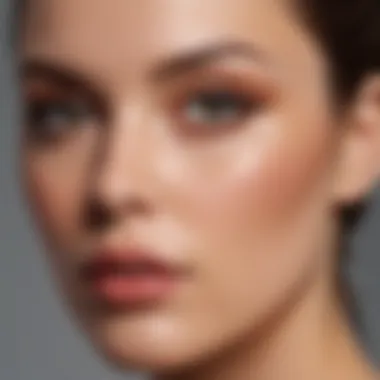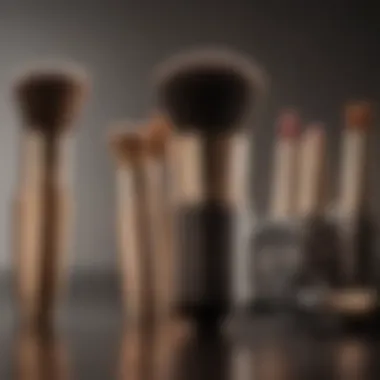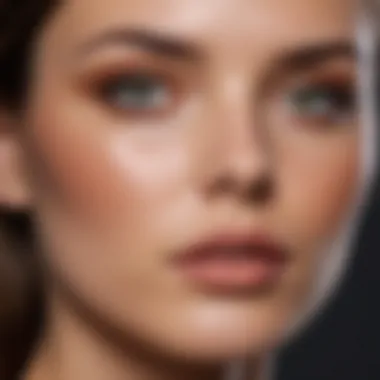Mastering Micro Contouring Techniques for Flawless Beauty


Intro
Micro contouring is a refined method in the cosmetic realm, seeking to accentuate the natural structure of the face. It employs strategic placement of products to create more defined features using subtlety rather than excess. This nuanced approach makes it particularly appealing for individuals who appreciate a more understated aesthetic.
With beauty trends rapidly evolving, micro contouring stands at the forefront, skilfully blending artistry with technique. Knowing how to achieve the desired look requires an understanding of skin types, product selection, and application methods. Therefore, we will dissect the fundamental principles behind micro contouring while offering practical guidance to empower all women in their beauty endeavors.
Understanding Micro Contouring
Micro contouring represents a sophisticated approach to makeup that finely adjusts and improves facial features. Unlike traditional contouring, it focuses on subtle application to create natural-looking enhancements. Understanding this technique is valuable for anyone interested in elevating their makeup skills. Awareness of how to effectively use micro contouring can lead to better facial balance and dimension.
The practice uses strategic product placement to sculpt the face while maintaining a soft and refined appearance. This section explores the definition and historical context of micro contouring, shedding light on its significance in today’s beauty landscape.
Defining Micro Contouring
Micro contouring is often defined as the art of applying makeup products in delicate amounts and specific areas to enhance one's features without overwhelming them. This approach requires precision and knowledge of facial anatomy to achieve the desired effect. By using lighter and darker shades, one can create shadows and highlights that mimic natural light.
The essential goal is to illuminate certain parts of the face while subtly shadowing others. This method emphasizes the beauty of natural facial structure. In micro contouring, the products used are usually lightweight with buildable coverage, ensuring that the final look does not appear heavy or exaggerated. It is also about understanding the areas to enhance depending on the unique face shape of the individual.
Historical Context
The history of contouring can be traced back to ancient civilizations where makeup was utilized for various cosmetic and ceremonial purposes. Over time, the techniques evolved, influenced by social and cultural shifts. The significant rise of contouring began in the early 2010s, thanks in large part to social media platforms like Instagram and the presence of influencers.
Makeup artists and celebrities popularized the technique of heavy contouring, which often yielded dramatic transformations. However, as preferences shifted toward more natural beauty, the concept of micro contouring emerged. This transition reflects an overall movement towards authenticity and the appreciation of subtlety in makeup. The evolution from bold alterations to nuanced enhancements has underscored an important lesson in the beauty community: less can indeed be more.
The Science of Contouring
Understanding the science behind contouring is crucial for mastering micro contouring. This technique emphasizes anatomical features and employs color theory to create the illusion of depth and dimension on the face. Through this article, we will analyze the essential elements of facial anatomy and how color manipulates perception, ultimately giving beauty enthusiasts the tools they need for effective application.
Facial Anatomy and Contouring
Facial anatomy plays a significant role in contouring. Each person's structure varies, influencing how makeup can enhance or alter their look. Key anatomical features include the cheekbones, jawline, nose, and forehead. Knowing the locations of these features allows for targeted application of contour and highlight products.
- Cheekbones: Highlighting the highest point creates a lifted effect.
- Jawline: Contouring the jaw can define and sharpen the face shape.
- Nose: Subtle shading can elongate or narrow the appearance of the nose.
- Forehead: Contouring the top can create a more oval appearance if desired.
Understanding these aspects leads to enhanced application skills. Consider face mapping techniques to determine the best approach for your unique shape.
Color Theory and Shadows
Color theory forms the foundation for effective micro contouring. Understanding basic principles can transform the way one applies makeup. The core idea revolves around the concept of light and shadow. Darker hues recede, creating shadows, while lighter tones project forward, emphasizing highlights.
- Cool Undertones: Use ashy tones for contouring purposes.
- Warm Undertones: Opt for warmer shades to add warmth and glow.
Utilizing the right colors allows for effective camouflage of imperfections and highlights desirable features. Adjusting the balance of light and shadow results in a well-defined and polished appearance.
"The right match of shades can transform one's face, revealing the inherent beauty through the science of shadows."
By mastering the interplay between facial anatomy and color theory, individuals can achieve a refined application that highlights personal features. This knowledge empowers users and replaces uncertainty with confidence in their daily routines.
Essential Tools for Micro Contouring
Essential tools for micro contouring are crucial for executing the technique effectively. The right products and application tools make a significant difference in achieving a natural and polished look. Understanding these tools empowers individuals to enhance their features without emphasizing the makeup itself. This section focuses on the necessary makeup products and the tools that facilitate successful micro contouring.
Makeup Products Required
To begin micro contouring, choosing the right makeup products is essential. The primary products include foundation, concealer, contour and highlight shades. Here are the significant products to have:
- Foundation: This creates a base. It should match the skin tone closely. A light coverage foundation is often preferable for a natural look.
- Concealer: Used for subtle corrections. A slightly lighter shade than the foundation helps in brightening areas like under the eyes or the center of the forehead.
- Contour Products: These come in cream, liquid, or powder forms. Choose shades one to two tones darker than skin tone. Cream contours are blendable and ideal for layering, while powders finish looks effectively.
- Highlighters: The goal is to bring light to certain areas of the face. Select a formula that suits the skin texture. Liquid highlighters provide a dewy finish, while powder highlighters offer shine.
When selecting products, consider the skin type as well. Oily skin benefits from matte formulas, while dry skin looks better with luminous products.


Application Tools
The tools used in micro contouring significantly affect the outcome. Various brushes and sponges can provide different effects. Here’s a breakdown of the essential tools:
- Makeup Brushes: Different brushes serve distinct purposes. For contouring, a small angled brush is ideal for precise application. A fluffy brush will help blend edges seamlessly.
- Beauty Sponges: They are crucial for blending, especially with cream products. A damp sponge offers a natural finish and ensures that makeup melds smoothly into the skin.
- Fingers: Sometimes, using fingers for application brings warmth to the product. This can aid in blending creams more effectively.
- Setting Spray: Although not a direct application tool, a setting spray finalizes the look. It helps maintain the makeup throughout the day, ensuring longevity.
Key Insight: Choosing the right products and tools is not merely a matter of preference; it significantly influences the effectiveness and finish of micro contouring.
In summary, essential tools for micro contouring, including specific makeup products and application tools, are vital for creating a sophisticated look. Understanding these aspects prepares anyone dreaming of mastering this technique.
Techniques for Effective Application
Effective application techniques in micro contouring are paramount for achieving a polished and natural look. Understanding the methods to apply contour and highlight can profoundly influence the final result. Micro contouring requires precision; thus, one should pay keen attention to the areas that need emphasis or softening.
Mastering these techniques allows individuals to emphasize their best features while minimizing any perceived flaws. Additionally, proper techniques also contribute to blending and layering products effectively, which significantly affects the overall appearance. As with any makeup method, practice is essential. Experimenting with different styles helps to discern what works best for one's unique features and skin type.
Step-by-Step Guide
- Preparation: Start with a clean, moisturized face. This provides a smooth base for application.
- Select the Right Products: Choose contour and highlight products that match your skin tone. Creams may offer a softer finish, while powders are easier to blend.
- Apply Contour: Using the contour product, apply it to the sides of your nose, under your cheekbones, and along your jawline. For a softer look, opt for a smaller brush that allows for precision.
- Highlight: Apply the highlight on the high points of your face—on top of your cheekbones, down the bridge of your nose, and your brow bone. This adds dimension and lifts the appearance of your face.
- Blend: Using a clean brush or beauty sponge, gently blend the contour and highlight. This is where the magic happens; seamless blending is crucial to avoid harsh lines.
- Set Your Look: Finally, set the makeup with a translucent powder to ensure longevity throughout the day.
Layering and Blending
Layering and blending are central concepts in micro contouring that elevate the look from basic to professional. Each step in the method should harmonize without conflicting textures or colors. When layering, one should start with thin layers. Gradually build intensity instead of overloading areas with product. This method not only enhances the features but also allows for more control over the final result.
- Layering Tips:
- Blending Techniques:
- Use a light hand when applying the initial products.
- Wait for products to dry before adding additional layers.
- Experiment with different product combinations to find what works best for your face structure.
- Always blend towards the center of your face, which helps to create a natural shadow effect.
- For cream products, using a damp sponge can facilitate smoother blending.
- For powders, a fluffier brush can help diffuse harsh lines, creating a soft transition between colors.
"The secret to a natural look is not just in the application, but also in the art of layering and blending. Each stroke matters."
By practicing these techniques, individuals can refine their skills in micro contouring, leading to a more polished finish that enhances their unique beauty.
Common Pitfalls in Micro Contouring
Understanding common pitfalls in micro contouring is crucial for achieving a polished look. Many individuals may overlook these mistakes, leading to less-than-desirable results. This section will emphasize specific elements that can make or break the contouring process. By identifying these issues, you can enhance your technique and boost your confidence when applying makeup.
Over-Application
One significant mistake in micro contouring is over-application of products. Micro contouring is all about subtlety, using small amounts of product to define and enhance the natural structure of the face. When too much product is layered on, it can create a harsh and unnatural appearance. This is particularly true for contouring creams or powders, which can settle into fine lines or pores, leading to a cakey look.
To avoid over-application, begin with a tiny amount of product. You can always add more, but it's challenging to remove excess once it's applied. Start with the hollows of your cheeks, temples, and jawline. Use a light hand, gradually building up the layers if needed. Remember, the goal is to enhance your features without overwhelming them.
Choosing the Wrong Shades
Another common pitfall is choosing the wrong shades for your skin tone. Different skin types require different contouring colors to create a natural effect. The wrong shades can lead to an unflattering look that may not blend well with your skin. For instance, a contour shade that is too dark or too cool can create a stark contrast, appearing unnatural.
To find the suitable shades, consider your undertones. If you have warm undertones, look for warm, golden shades for contouring. Conversely, cooler undertones may benefit from taupe or ash-colored products. Testing the shades in natural light can help you identify what works best.
"The right shades make all the difference in achieving a flawless micro contouring look."
Being mindful of these pitfalls will enhance your micro contouring experience, providing a more effective and beautiful outcome. Paying close attention to the amount of product applied and the shades chosen can lead to a radiant finish that boosts your self-esteem. Remember, practice and patience are key to mastering micro contouring.
Micro Contouring for Different Face Shapes
Micro contouring adapts to the unique geometry of each face. It is critical to understand the differences in facial shapes when applying contouring techniques. Each shape has its own characteristics, and recognizing these is key for enhancing natural features without creating stark lines or overwhelming the face. This tailored approach can make a significant difference in achieving a refined and balanced look. Here are some essential elements, benefits, and considerations when it comes to micro contouring for various face shapes.
Oval Face
The oval face is often considered the ideal shape in the beauty community. The symmetry and gently rounded jawline create a harmonious balance. When contouring an oval face, the goal is to maintain this balance while enhancing specific areas.


To achieve this:
- Highlight the forehead: Apply a subtle highlighter along the center of the forehead to draw attention upwards.
- Contour the cheeks: Use a soft contour to define the cheekbones. This can help to create depth without altering the natural shape.
- Jawline definition: Lightly contour the jawline to add subtle definition, focusing on the areas where shadows naturally occur.
Round Face
A round face is characterized by full cheeks and a soft jawline. The goal when contouring this shape is to elongate and create the appearance of more defined angles.
Here are some effective methods for achieving a more sculpted look:
- Cheekbone enhancement: Start with contouring beneath the cheekbones, blending it upwards. This creates the illusion of higher, more sculpted cheeks.
- Forehead contouring: Contour the sides of the forehead to add length and narrow the face slightly. This technique creates a more balanced appearance.
- Jawline definition: Focus on contouring along the jawline, but be cautious with the amount applied to avoid a harsh look. A subtle definition will suffice.
Square Face
A square face is identified by strong angles and a robust jawline. Contouring techniques should aim to soften these features and create a more oval appearance.
Key strategies include:
- Softening the jawline: A key step involves applying contour along the jawline and blending it well. This can minimize the appearance of a strong jaw.
- Cheek contouring: Apply contour to the cheeks, focusing on the edges. This technique will help achieve a rounder appearance in the cheek area.
- Forehead contour: Contour the corners of the forehead to create softness. This will also contribute to narrowing the face visually.
"Understanding your face shape is paramount in contouring. Tailoring your technique enhances natural beauty while remaining mindful of the unique features that define you."
In summary, micro contouring is versatile enough to adapt to various face shapes. Each approach seeks to enhance the natural beauty through care and precision, making it essential for anyone looking to refine their makeup skills. Always remember: it’s not about changing who you are but highlighting the best aspects of your features.
Sustainability and Ethics in Beauty Practices
Sustainability and ethics in beauty practices have gained significant attention in recent years. This shift reflects a growing awareness of environmental challenges and a call for transparency in the beauty industry. Micro contouring, a nuanced makeup technique, is not exempt from these considerations. As consumers become mindful of their choices, the demand for sustainability and ethical practices in beauty continues to grow.
With micro contouring often involving various products, it is essential to assess their impact on the environment. Beauty brands are now prioritizing eco-friendly formulations, which tend to contain fewer harmful chemicals and ingredients that may contribute to pollution. This focus not only benefits the environment but also aligns with the values of many consumers who seek products that are responsible and effective.
Furthermore, opting for sustainably made products supports a move towards more responsible sourcing of materials. Many brands are working towards reducing their carbon footprint by adopting greener packaging and manufacturing processes. This transformation is crucial, as it encourages the industry to rethink its practices while also providing consumers with a choice that resonates with their values.
"The future of makeup relies on our ability to innovate while preserving our planet."
Additionally, ethical considerations extend beyond environmental impacts to include social responsibility. Consumers are increasingly interested in brands that uphold fair labor practices, ensuring that workers are treated fairly and compensated justly. This knowledge empowers consumers to make informed decisions when purchasing products for micro contouring and other beauty techniques.
This section will further explore:
- Eco-Friendly Products: Understanding what makes a product eco-friendly and how it affects application.
- Cruelty-Free Options: Exploring the importance of cruelty-free practices in modern beauty products.
The Evolution of Contouring Trends
The evolution of contouring trends reflects a significant shift in beauty standards and practices. In the past, makeup application centered mainly around creating an overall polished look. Contouring, in particular, emerged as a technique for sculpting the face using both light and dark shades. This section seeks to elaborate on the transition from heavy contouring to micro techniques, emphasizing the benefits and considerations that accompany these changes.
As public awareness of makeup artistry increased, so did the conversation around its various methodologies. Understanding the evolution gives insight into individual preferences for makeup applications based on lifestyle, taste, and even social context.
From Heavy to Micro Techniques
Heavy contouring was once the hallmark of celebrity makeup, characterized by pronounced shadows and highlights. This method often involved placing thick layers of product in strategic areas to create stark contrasts. Many people felt intimidated by this approach, as it required a level of skill and experience that not everyone possessed. However, over time, beauty influencers and makeup artists began to advocate for a more subtle approach.
Micro contouring emerged as a less intimidating alternative. Instead of drastic shading, it emphasizes natural bone structure and soft enhancements. The technique involves applying minimal product to accentuate facial features without looking overly made-up. Here are some key aspects of this shift:
- Increased Focus on Realism:
The demand for more realistic appearances contributed significantly to the popularity of micro techniques. - Accessibility:
With easier steps and minimal product requirements, micro contouring has become approachable for a wider audience. - Cultural Shifts:
The rise of social media created a platform for diverse beauty expressions, allowing individuals to experiment with micro contouring and share results.
Social Media Influence
Social media has played a pivotal role in shaping contouring trends. Platforms like Instagram and TikTok encourage creativity and experimentation, making beauty techniques more accessible. The rise of tutorials and real-time demonstrations has demystified micro contouring for many.
"Social media allows for trends to propagate rapidly, spreading ideas and techniques that may have otherwise remained local or niche."


Key points regarding social media's influence on micro contouring include:
- Community Feedback: Users share their experiences and techniques, fostering a supportive environment.
- Trend Cycles: The quick turnover of trends has shifted focus away from heavy applications, leading to the embrace of micro techniques.
- Real-Life Applications: Influencers often showcase practical, day-to-day applications of micro contouring, illustrating its suitability for various lifestyles.
Incorporating Micro Contouring into Daily Routines
Micro contouring serves as a versatile tool in a makeup routine. It can significantly enhance one's daily appearance without the drastic effects typically associated with traditional contouring methods. This technique allows for subtle adjustments that can elevate cheekbones, sharpen jawlines, and add dimension to the face.
The importance of incorporating micro contouring into daily routines goes beyond mere aesthetics. It provides a means for self-expression, boosting confidence in one's appearance. Practical and effective, micro contouring can fit well even in busy schedules.
Time-Efficient Methods
In a fast-paced world, finding time for elaborate makeup routines can be challenging. However, micro contouring offers several time-efficient methods to achieve great looks without lengthy application.
- Streamlined Product Selection: Choose multi-purpose products that can serve as foundation, highlighter, and contour. Brands like Tarte Cosmetics offer contour palettes that have products specifically designed for quicker application.
- Quick Application Tools: Utilize brushes equipped with dense bristles or beauty sponges. They apply product evenly and speedily, making the contouring process less time-consuming.
- Practice Speed Techniques: Familiarize yourself with areas needing contour and highlight. Concentrate on three points: the sides of the nose, under the cheekbones, and along the jawline. This focus can cut down on application time significantly.
Customizing Techniques for Everyday Looks
Customizing micro contouring techniques allows for versatility while accommodating various occasions. A daily routine should feel seamless and adaptive to one's unique facial features and personal preferences.
- Adjust Product Intensity: Depending on the day, one can choose lighter shades for a natural look or more pronounced colors for an evening out. Clarins offers a range with buildable coverage, allowing one to seamlessly transition from day to night.
- Incorporate Skin Type Considerations: For oily skin, select matte products that resist shine. Conversely, dry skin may benefit from creamy textures. Products from Fenty Beauty can be suitable for varied skin types, enhancing the customization process.
- Focus on Desired Features: When customizing looks, all women should identify features they wish to accentuate. A stronger highlight on cheekbones can contrast with a more subdued approach on the forehead. This tailored method keeps the end result polished but distinctively personal.
Micro contouring adapts effortlessly into personal routines. As this technique brings out the best of an individual's unique features, the result is vitality and renewed confidence. Being efficient and adaptable transforms something that may seem complex into an essential daily ritual.
Expert Opinions and Testimonials
In the realm of micro contouring, expertise adds depth and credibility to the practice. Understanding the perspectives of seasoned makeup artists and community members provides valuable clarity on how to effectively incorporate this intricate technique into daily routines. Insights from professionals and testimonials from everyday users help illuminate the efficacy and versatility of micro contouring. This section will explore the significance of expert input and firsthand experiences, offering tips and advice rooted in real-world application.
Interviews with Makeup Artists
When discussing micro contouring, interviews with makeup artists serve as an invaluable resource. Professional makeup artists bring years of experience to the table. They understand the nuances of skin types, lighting, and color theory, which are all pivotal in micro contouring. Their tips often highlight how to achieve natural-looking results that enhance rather than mask one's features.
Practical Benefits:
- Makeup artists frequently emphasize the importance of using the right tools. They suggest investing in high-quality brushes and sponges, which can significantly impact the final appearance. For instance, a good blending sponge can seamlessly merge contour products into the skin for a flawless finish.
- Many artists recommend starting with light layers and gradually building up the product. This technique minimizes the risk of over-application, a common pitfall in novice contouring attempts.
- Additionally, experts often share brand-specific recommendations for foundations and highlighters, aiding readers in making informed choices.
"Micro contouring is about celebrating your unique features. By starting subtly and adjusting as needed, you find what truly highlights your beauty."
— [Name], Professional Makeup Artist
Community Insights
Community insights provide a grassroots perspective on micro contouring. Real users share their experiences, challenges, and victories. This feedback is crucial for understanding how the technique resonates beyond professional settings.
Key Points from the Community:
- Diverse Perspectives: Users of various ages and backgrounds often discuss how micro contouring techniques can be tailored to different skin types and tones. This adaptability showcases the technique's universal appeal.
- Common Challenges: Community discussions reveal frequent mistakes, such as incorrect shade selection or improper blending. These insights help beginners avoid the same pitfalls and refine their approach.
- Value of Tutorials: Many community members highlight the usefulness of online tutorials. Video demonstrations enable users to witness techniques in action, facilitating a better understanding of application methods.
Micro contouring is not just a trend but a practical technique that grows more refined with input from experts and everyday users alike. These opinions and experiences collectively enrich the practice, ensuring it remains relevant and approachable to all.
Ending: The Future of Micro Contouring
Micro contouring is not just a trend; it is shaping the future of makeup application by embracing sophistication alongside accessibility. As consumers become increasingly aware of their choices related to beauty products, understanding the nuances of micro contouring will empower them to enhance their features without overwhelming their natural look. The future of micro contouring lies in leveraging advanced technologies and innovative applications that offer streamlined solutions, making it easier for women of all ages to incorporate these techniques into their daily routines.
the Role of Technology
The role of technology in micro contouring is pivotal. Innovative makeup tools like digital apps can now provide personalized recommendations based on an individual’s facial structure and skin tone. These advancements allow users to visualize the effects of different contouring techniques before applying any product. Brands are increasingly launching airbrush technology and smart mirrors which offer lighting adjustments and visualizations of contouring outcomes.
- Augmented Reality: Many apps allow users to test various makeup looks virtually. They can see how different shades impact their features without physically applying products, reducing the need for trial and error.
- 3D Facial Mapping: This technology reveals where to apply products for optimal enhancement, leading to a more precise and tailored contouring experience.
These technologies make micro contouring more accessible and less intimidating for beginners, while also providing seasoned practitioners with tools to refine their artistry further.
Potential for Innovation
The potential for innovation in micro contouring is significant as beauty consumer preferences continue to evolve. As sustainability gains importance in the industry, brands are now formulating eco-friendly and cruelty-free products that do not compromise quality. Innovations include utilizing plant-based dyes and biodegradable packaging.
- Smart Formulations: Future products may feature adaptive formulas that adjust to individual skin types upon application, ensuring a flawless finish.
- Customization: Brands are exploring customizable palettes where users can select colors best suited for their unique skin tones. This personalization will ensure a broader appeal and satisfaction among users.
The intersection of art and science in micro contouring will likely yield exciting developments, transforming it into a pressing dynamic field within the beauty industry. Embracing these changes and innovations can define the next chapter in the evolution of makeup artistry.







